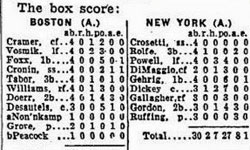
Orioles-Mets box score from Aug. 20, 2015 (Flickr Photo Mike Fitzpatrick)
Once you deciphered the code, the box score provided almost everything you needed to know about a game. It told you that Mickey Mantle went 1 for 3 with a run scored as the result of his 36th homer of the season. Or that Sandy Koufax recorded 13 strikeouts in shutting out the Giants.
The box score has been a staple of newspapers since the 1800s. Yet like everything else in the ever changing world of media, its future is precarious in print editions, as sports editors wrestle with diminishing space and resources. They also wonder if running the box scores is essential given their instant availability on a multitude of websites.
The Charlotte Observer, along with sister papers the Raleigh News & Observer and the Rock Hill Herald, took the step and eliminated the baseball scores from their print editions this year. Mike Persinger, the sports editor of the Charlotte Observer, said it was a move that had been discussed for the last 6 or 7 years.
“We always came away thinking, ‘It’s too soon,'” Persinger said.
However, budget cutbacks forced the papers to reconsider the decision this year. Persinger said the baseball box score page (which the three papers share) took a staffer four hours (a half-shift) to produce. The sports editors felt those resources could be used elsewhere.
“It was not an easy decision, but in some ways it was,” Persinger said. “Why were we running something that is widely available elsewhere? For most of our younger readers, if they care about the Red Sox, or want the latest on their fantasy team, they are going to get those statistics and box scores elsewhere and get them faster than they would in the newspaper.”
As you would expect, the majority of complaints came from older readers. Persinger said he personally responded to more than 700 calls and emails from readers who objected to the decision.
“I understand where they are coming from,” Persinger said. “I broke a habit that in some cases goes back 50 to 60 years. A habit of waking up in the morning and looking at the box scores in the paper.”
Speaking personally, I broke my newspaper box score habit several years ago with the dawn of the digital age. I get the White Sox box scores sent directly to my phone immediately after games. Given the season they have had, it is remarkable my phone still is in one piece.
I also have a professional reason why I advocate getting rid of the baseball box score in newspapers. As a contributor on sports media for the Chicago Tribune, it is frustrating to hear that a column has to hold in the print edition because of a lack of space.
Last week, I made the argument to Joe Knowles, the Trib’s associate managing editor for sports, the paper’s readers would be better served with a full page of interesting stories from staffers, including my columns, rather than a full page of baseball box scores, many of which are meaningless games in September.
In an email, Knowles acknowledged that the “clock is ticking on (baseball) box scores.” Interestingly, the Tribune already has eliminated running NBA and NHL box scores, a decision that Knowles said generated only a handful of complaints. He still plans to run NFL summaries in print because of fantasy football players. However, he notes, “I doubt many of those people rely on the printed newspaper for that data.”
Knowles writes of baseball box scores:
“Agate in general feels a bit like an anachronism in the newspaper and we have been scaling it back gradually for a while now. Right now, with the Cubs being relevant again, I don’t think we’d pull the plug on baseball agate for 2016, but conditions – foreseen and unforeseen — may dictate that we consider it.”
Circumstances already prevailed for the papers in North Carolina. Persinger said some of the disgruntled readers are appeased when he informs them that the box scores can be found in the Observer’s digital edition.
However, Persinger knows for some readers, the online version isn’t an option.
“For whatever reason, there are some people who won’t use a computer,” Persinger said. “Those are the people I feel the worst about. But I can’t help them. It’s just the way our industry is changing.”
******
Recommended reading on sports journalism:
Jeff Pearlman has a riveting Q/A with Sports Illustrated Michael Farber, “the Wayne Gretzky of hockey writers.”
Bryan Curtis of Grantland examines the coverage of Deflategate.
The new media center at the U.S. Open Tennis Center is named after Bud Collins. Harvey Araton of the New York Times visits with the colorful legend.
******
Ed Sherman writes about sports media at shermanreport.com. Follow him @Sherman_Report.






